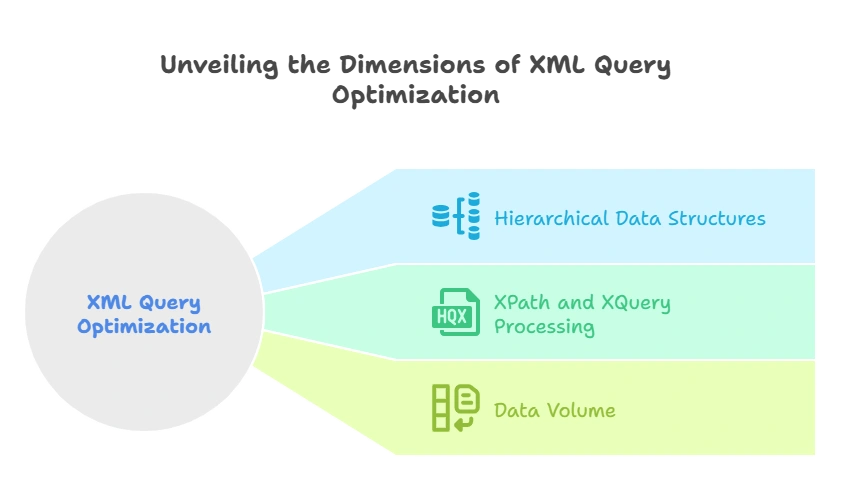Optimization of XML Queries for Performance
Optimizing XML queries is essential to improve processing speed, reduce resource consumption, and enhance overall system efficiency. XML queries often involve complex data structures, which can lead to slower processing times, especially with large datasets. This chapter provides a complete, in-depth guide to XML query optimization, from understanding the basics to exploring advanced techniques, supported with examples and code explanations.
Introduction to XML Query Optimization
XML query optimization involves methods to improve the efficiency of XML queries, focusing on reducing execution time, minimizing memory usage, and optimizing I/O operations. Key challenges in XML querying are:
- Hierarchical Data Structures: XML stores data hierarchically, making traversal complex.
- XPath and XQuery Processing: These query languages are powerful but require careful use to avoid performance hits.
- Data Volume: Large XML files can significantly slow down query performance if not optimized.
Understanding XML Query Languages: XPath and XQuery
- XPath: A language for navigating XML documents using paths to access nodes, elements, and attributes.
- XQuery: A more comprehensive language built on XPath, providing a syntax for querying and transforming XML data.
Example of an XPath Query:

<bookstore>
<book category="children">
<title>Harry Potter</title>
<author>J.K. Rowling</author>
<price>29.99</price>
</book>
</bookstore>
XPath to Select All Book Titles:
/bookstore/book/title
This query navigates through each book element and retrieves the title.
Strategies for Optimizing XML Queries
Use Indexing for Faster Data Retrieval
Indexing enables faster access to XML data by creating shortcuts to frequently accessed elements and attributes.
Creating an XML Index:
Many databases support XML indexing, such as Primary and Secondary indexes in SQL Server’s XML type or XQuery index in Oracle.
Example: Creating an XML index in SQL Server
CREATE PRIMARY XML INDEX idx_xml ON MyXMLTable (xmlDataColumn);
Avoid Wildcard Selectors
Wildcards (*) can lead to inefficiency, as they select all elements and attributes. Instead, target specific nodes or attributes.
Example Without Wildcards:
/bookstore/book[price>20]/title
This query retrieves titles of books with prices over 20 without selecting all nodes.
Using Optimized XQuery Expressions
Use FLWOR Expressions Efficiently
FLWOR expressions (For, Let, Where, Order by, Return) allow iteration, filtering, and sorting, but they should be carefully constructed to avoid excessive computations.
Optimized FLWOR Example:
for $book in /bookstore/book
where $book/price > 20
order by $book/price
return $book/title
Explanation: This FLWOR expression only iterates through books with prices above 20, orders them by price, and retrieves titles, reducing unnecessary processing.
Minimize Use of Recursive Queries
Recursive queries can cause performance degradation. If possible, limit recursion depth or use alternative data structures to achieve similar results.
XML Schema Constraints for Performance Optimization
Using an XML schema can improve performance by enforcing structure, data types, and constraints, allowing parsers to optimize data loading and querying.
Example of an XML Schema:
<xsd:schema xmlns:xsd="http://www.w3.org/2001/XMLSchema">
<xsd:element name="bookstore">
<xsd:complexType>
<xsd:sequence>
<xsd:element name="book" maxOccurs="unbounded">
<xsd:complexType>
<xsd:sequence>
<xsd:element name="title" type="xsd:string"/>
<xsd:element name="price" type="xsd:decimal"/>
</xsd:sequence>
</xsd:complexType>
</xsd:element>
</xsd:sequence>
</xsd:complexType>
</xsd:element>
</xsd:schema>
Explanation: This schema enforces data type rules and structure, optimizing XML data validation and querying.
Reducing Data Transfer and Memory Usage
XML data can be verbose. To minimize memory and data transfer:
- Compress XML Files: Use GZIP or other compression techniques.
- Use Stream-Based Parsing: Stream parsers (e.g., SAX) process XML incrementally rather than loading it entirely, reducing memory consumption.
Example of Streaming XML Processing:
import xml.sax
class BookHandler(xml.sax.ContentHandler):
def startElement(self, tag, attributes):
if tag == "title":
print("Title:", attributes["name"])
parser = xml.sax.make_parser()
parser.setContentHandler(BookHandler())
parser.parse("bookstore.xml")
Explanation: This code only parses title elements in real time, lowering memory usage.
Effective XML query optimization can significantly enhance performance, especially in large-scale systems. By combining indexing, careful query structure, and schema constraints, XML data processing becomes faster and more resource-efficient. Happy coding !❤️
